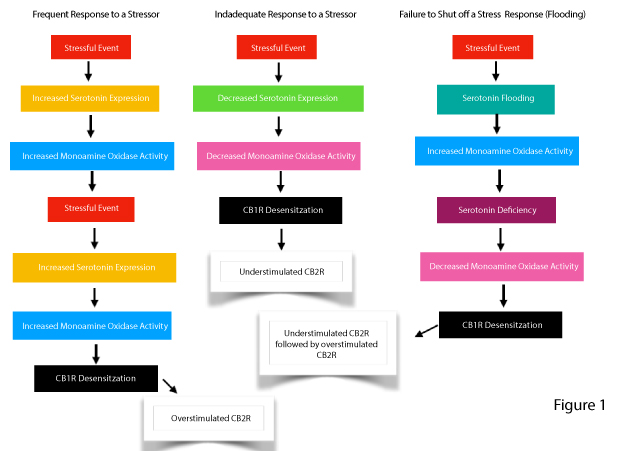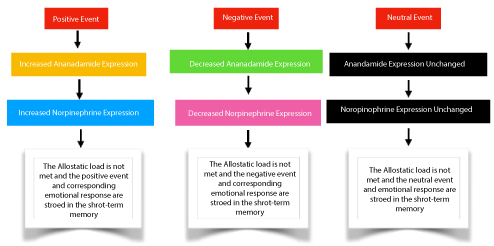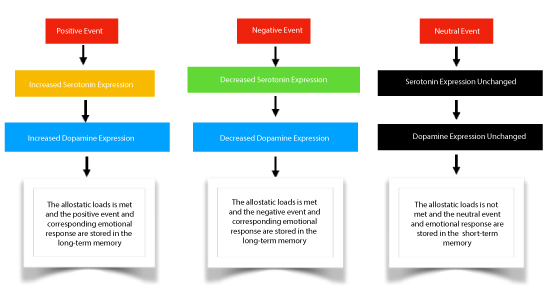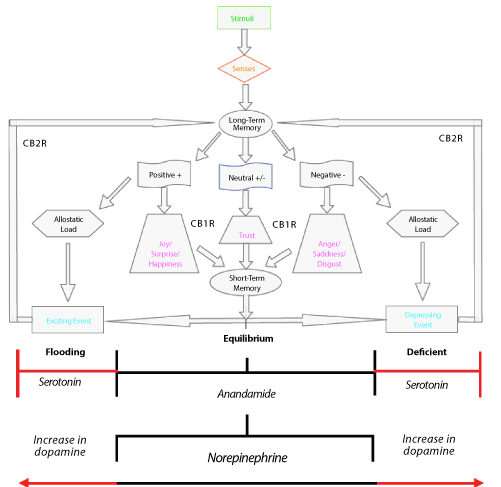Journal Name: Scholar Journal of Applied Sciences and Research
Article Type: Theoretical Literature
Received date: 23 January, 2019
Accepted date: 18 February, 2019
Published date: 25 February, 2019
Citation: Terry W (2019) CB2R Desensitization and Long and Short-Term Memory Storage. Sch J Appl Sci Res Vol: 2, Issu: 2 (13-17).
Copyright: © 2019 Terry W. This is an open-access article distributed under the terms of the Creative Commons Attribution License, which permits unrestricted use, distribution, and reproduction in any medium, provided the original author and source are credited.
Abstract
This paper is related to a previously submitted work titled: “How Allostatic Load Can Work to Desensitize the CB1R and an Analogy on How Anandamide and FAAH May Work to Influence Emotional States.” The CB2 receptor is responsible for maintaining equilibrium in the parasympathetic nervous system and controls immune responses in the body. A hindered immune system can be attributed to prolonged stress. When the allostatic load is met, this receptor could become desensitized and cause the event to be stored in long- term memory. CB2Rs are dominant in the spleen, which is responsible for the production and removal of blood cells in the body. In my previous paper, I hypothesized that the CB1R and the allostatic load contributed to the desensitization of the CB1Rs. I hope to follow up on this topic and explain how CB2Rs can become desensitized. I will provide my interpretation of how serotonin and dopamine work to desensitize the CB2Rs when the allostatic load is reached. I will provide my interpretation of how the two cannabinoid receptors are influenced, before and after the allostatic load has been reached, resulting in the storage of the emotional response and event in either the short-term or long-term memory.
Keywords
Short-term memory, Long-term memory, Emotional responses, CB2R genes, Serotonin.
Abstract
This paper is related to a previously submitted work titled: “How Allostatic Load Can Work to Desensitize the CB1R and an Analogy on How Anandamide and FAAH May Work to Influence Emotional States.” The CB2 receptor is responsible for maintaining equilibrium in the parasympathetic nervous system and controls immune responses in the body. A hindered immune system can be attributed to prolonged stress. When the allostatic load is met, this receptor could become desensitized and cause the event to be stored in long- term memory. CB2Rs are dominant in the spleen, which is responsible for the production and removal of blood cells in the body. In my previous paper, I hypothesized that the CB1R and the allostatic load contributed to the desensitization of the CB1Rs. I hope to follow up on this topic and explain how CB2Rs can become desensitized. I will provide my interpretation of how serotonin and dopamine work to desensitize the CB2Rs when the allostatic load is reached. I will provide my interpretation of how the two cannabinoid receptors are influenced, before and after the allostatic load has been reached, resulting in the storage of the emotional response and event in either the short-term or long-term memory.
Keywords
Short-term memory, Long-term memory, Emotional responses, CB2R genes, Serotonin.
Summary
This paper is an extension to a previous work titled: How Allostatic Load Can Work to Desensitize the CB1R and an Analogy on How Anandamide and FAAH May Work to Influence Emotional States.” This paper provides an interpretation on how the CB2 receptor (CB2R) is affected when the allostatic load is reached. Also, I will discuss my interpretation of how emotional responses and events are encoded in the short-term and long-term memory.
This paper is an extension to a previous work titled: How Allostatic Load Can Work to Desensitize the CB1R and an Analogy on How Anandamide and FAAH May Work to Influence Emotional States.” This paper provides an interpretation on how the CB2 receptor (CB2R) is affected when the allostatic load is reached. Also, I will discuss my interpretation of how emotional responses and events are encoded in the short-term and long-term memory.
In a study titled: “Cannabinoid Receptor Agonists Upregulate and Enhance Serotonin 2A (5-HT(2A) Receptor Activity via ERK1/2 Signaling,” [1] it was suggested that a selective CB2R agonist produced a strong up-regulation of 5- HT2A receptor mRNA and protein, which did not occur when a selective CB2R antagonist, ERK 1/2 inhibitor, PD198306 was introduced. This study indicates that nonselective agonists of CB2Rs may work to regulate serotonin neurotransmission.
In my previous paper, I hypothesized that differences in anandamide and FAAH could lead to short-term emotional responses. In relation to the CB2Rs, serotonin and monoamine oxidase could work to influence long-term emotional responses. In a study titled: “Serotonin and emotion, learning and memory” [2] it was stated that Serotonin has been associated to emotional and motivational aspects of human behavior. Like anandamide, serotonin has been labeled as a “feel good” chemical. These studies suggest that there is a relationship between the CB2Rs, serotonin and emotion.
The CB2Rs can also be associated to dopamine and long-term memory storage. In a study titled: “Dopamine, A Neurotransmitter, Influences the Immune System,” [3] it was found that in vivo damage or stimulation of specific central dopaminergic systems either suppresses or increases functional activities of the immune effector cells.
CB2Rs are mainly located in the spleen and are responsible for immune responses. If it was found that dopamine influences the immune system, then the CB2R might lead to dopamine signaling. Another study titled: “Cannabinoid CB2 Receptor Modulate Midbrain Dopamine Neuronal Activity and Dopamine- Related Behavior in Mice,” [4] found that CB2R genes and receptors are expressed in midbrain dopamine neurons and that CB2R activation leads to dopamine neuronal firing. If the CB2Rs are related to dopamine firing, then they may play a role in long-term memory storage. In another study titled: “Dopaminergic Modulation of Long-term Synaptic Plasticity in Rat Prefrontal Neurons” [5] it was suggested that dopamine facilitates longterm potentiation and that dopamine receptors must be prestimulated before the application of high-frequency stimuli. So, the chemical releases of dopamine and serotonin might be signaled by the CB2Rs to provide a recovery response to a negative or positive event and work to influence and store events and emotional responses in the long-term memory. Figure 1 represents how the allostatic load of the CB2Rs can work to influence the expression of serotonin and monoamine oxidase activity. Variances in serotonin and monoamine oxidase might lead to the expression of the emotional responses and result in the storage in the longterm memory.
Figure 1: A representation of how the allostatic load of the CB2Rs can work to influence the expression of serotonin and monoamine oxidase activity. These variances in serotonin and monoamine oxidase lead to the expression of the emotional response and the storage in the long-term memory.
The spleen is known to filter the blood in the body through the production and removal of blood cells. The immune responses associated with the CB2Rs occur in the parasympathetic nervous system. Stressful events and responses can be attributed to both short-term (CB1Rs emotion and events) and long-term (CB2Rs emotion and events) memory storage. A study titled: “Dopamine Controls Persistence of Long-Term Memory Storage,” [6] found that the persistence of long-term memory is dependent on the activation of ventral tegmental area/hippocampus dopaminergic connections and can be particularly modulated by manipulating this system with an agonist at decisive postlearning time points. This hippocampal region is associated to the long-term memory.
If the hippocampus is damaged, it could be observed that the formation of long-term memory does not take place, while the short-term memory can remain intact. Another study titled: “Short and Long-Term Effects of Cannabinoids on the Extinction on Contextual Fear Memory in Rats,” [7] it was found that the endocannabinoid system regulates shortterm, fear memory extinction with long-lasting outcomes. Dopamine has been shown to convert to norepinephrine. Like dopamine, norepinephrine can be related to function in memory storage.
In my previous paper, I associated the CB1Rs to chemical releases in the adrenal axis. Norepinephrine is released from the adrenal medulla into the blood stream. The adrenal medulla is accessed during a fear response. Norepinephrine levels are lower when sleeping. Decreased levels while sleeping could hinder the retention of events and emotions in the memory. This could indicate why we generally have a difficult time remembering our dreams. Norepinephrine is known to aid in attention. In a study titled: “Role of amygdala norepinephrine in mediating stress hormone regulation of memory storage,” [8] it was indicated that there is a sizable amount of evidence showing that the noradrenergic system of the amygdala, specifically the basolateral nucleus of the amygdala, is involved in the consolidation of memory. If anandamide, that is released out of the adrenal axis and can work to produce short-term emotional responses, then norepinephrine could function in obtaining attention and work to encode events and emotions in the short- term memory. This short-term memory storage would occur in the absence of the allostatic load. Figure 2 is a representation of how variances in anandamide and norepinephrine could work to store events and emotional responses in the shortterm memory.
Figure 2: A representation of how variances in anandamide and norepinephrine could work to store events and emotional responses in the short-term memory.
Figure 3 is a representation how positive and negative events can be stored in the long-term memory through variances in the expressions of dopamine and serotonin.A neutral response would not be stored in the long-term memory because the allostatic load is not achieved. Since the allostatic load was not achieved, a trust response would be stored in the short-term memory. This is why trust can be frequently reinforced, but can be easily lost and hard to gain back. Given the evidence provided, it seems that there large amount of information indicating that the CB1Rs and CB2Rs can signal chemical responses to encode emotions and events in the short-term and the long-term memory. Also, just like the CB1Rs, the CB2Rs can become overloaded and reach the allostatic load.
Figure 3: A representation of how positive and negative events can be stored in the long-term memory through variances in the expressions of dopamine and serotonin. A neutral response would not be stored in the long-term memory because the allostatic load is not achieved. Since the allostatic load was not achieved, a trust response would be stored in the short-term memory.
In my previous work, I talked about how the allostatic load could affect the CB1Rs leading to their desensitization. If the allostatic load is achieved, then the CB2Rs could become desensitized as well. In a study d the “Role of CB2 Receptors in Social and Aggressive Behavior in Male Mice,” [9] results suggested that the CB2R is associated with social interaction and aggressive behavior. In my previously submitted paper, aggression could be attributed to the allostatic load being achieved. So, could the CB2Rs become desensitized in a similar way that the CB1Rs can? When the CB2Rs continually filter damaged blood cells created by frequent, intense or deficient reactions to a single or repeated stressful event, they could become desensitized. This occurs when the endocannabinoid system (ECS) cannot regain homeostasis. The stressful event could be encoded through our cannabinoid receptors, located in our sensory organs, and signal chemical releases in the body. When a more intense, more frequent release, or flooding of chemical messengers occurs, the allostatic load is achieved. Examples can be given for a small release, which could store the emotional response and event in the short-term memory, and a large release, which could store the emotional response and event in the long-term memory.
For instance, an emotional reaction to a small, negative event (biting your lip), may lead to a shortened emotional response and result in the storage into the short-term memory. Another extreme is a large emotional reaction to a massive, negative event (near-death experience), which may lead to the storage of the event into the long-term memory. This can also be seen in a small, positive reaction (someone told a joke) or a massive, positive reaction (you won the lottery).
If the CB1Rs influence the chemical releases of epinephrine and norepinephrine and the CB2Rs influence the chemical releases of dopamine and serotonin the following could be observed; When the CB1Rs are encountering the allostatic load, an increased heart rate, opening of the airways, dilated pupils and constricted vessels can be observed. When the CB2Rs are encountering the allostatic load, a decreased heart rate, closing of the bronchial tubes, constricted pupils and dilated vessels can be observed. The CB1Rs’ and CB2Rs’ functions could be compared with the yin and yang as they work in unison, but have opposing purpose. The CB1Rs are associated with a fight-or-flight emotional response, while the CB2Rs are associated with the recovery response. Therefore, I hypothesize that the CB1Rs are associated to the short-term memory storage of positive, negative and neutral events and corresponding emotional responses and that the CB2Rs are associated to the long-term memory storage of positive and negative events and emotions, given the allostatic load. This leads me to hypothesize that the CB2Rs could become desensitized. Also, serotonin could ultimately be affected when desensitization occurs. Given that the CB2Rs could be desensitized the following might occur: When the CB1Rs encounter the allostatic load and become overstimulated through the signaling of epinephrine and norepinephrine, the CB2Rs will reach the allostatic load and become desensitized. Upon desensitization, the overstimulation of the CB2Rs could ultimately lead to the overstimulation of the whole endocannabinoid system. In this case, the event and corresponding emotional response would be stored in the long- term memory. When the CB1Rs encounter the allostatic load and become under-stimulated through the signaling of epinephrine and norepinephrine, the CB2Rs can reach the allostatic load and become desensitized. Upon desensitization, the under- stimulation of the CB2Rs could ultimately lead to the under- stimulation of the whole endocannabinoid system. In this case, the event and corresponding emotional response would be stored in the long-term memory. When the CB1Rs encounter the allostatic load and become Flooded with epinephrine and norepinephrine, the CB2Rs can reach the allostatic load and become desensitized. Upon desensitization, the CB2Rs would be under-stimulated, followed by overstimulation. Flooding could ultimately lead to the cyclical understimulation, followed by the overstimulation of the whole endocannabinoid system. In this case, the event and corresponding emotional response would be stored in the long- term memory. Also, in the three scenarios listed above variations in these chemical releases would either weaken or strengthen the memory storage. Higher amounts of dopamine and norepinephrine could be associated to strong memories and lower amounts to weaker memories. Given dopamines hypothesized function in the storage of longterm memories, serotonin could function in the formation of long-term emotional responses.
In my previous paper, I hypothesized that variations in anandamide and FAAH could work to arrive at emotional states. Given my previous work, I hypothesize that serotonin and monoamine oxidase can work in the same manner to arrive at the same emotional states. The only difference would be that serotonin and monoamine oxidase are associated with the storage of emotions in the long-term memory, while anandamide and FAAH are associated with the storage of emotions in the short-term memory.
Figure 4 combines all of my work and provides a representation of how the CB1Rs and CB2Rs can function to store emotional responses and events in the short-term and the long-term memory. It displays how emotions and events that have not achieved the allostatic load can be stored in the short-term and the long-term memory and how the allostatic load can influence the long-term storage of emotions and events. It also, represents how variations in chemical releases can influence this storage process by producing strong, neutral and weak emotional responses to stimuli.
Figure 4: Combines all of my work to provide a representation of how the CB1Rs and CB2Rs function to store emotional responses and events in the short-term or the long-term memory. It shows how emotions and events that have not achieved the allostatic load can be stored and how the allostatic load can influence the long-term storage of emotions and events. It also, represents how variations in chemical releases can influence this storage process by creating strong, neutral and weak emotional responses to stimuli.
In conclusion, the CB2Rs have been shown to become desensitized through their overstimulation or understimulation. I have provided examples of how an event can be stored in the short-term and/or the long-term memory for future retrieval. I have also described how the CB1Rs can work to store emotional responses and events in the short-term memory. I have described how CB2Rs can work to store emotions and events in the long-term memory. I have provided a representation of how the systems work to function in unison, but with opposing functions. If the CB2Rs are desensitized, then the whole endocannabinoid system could become out of balance and supplementing the imbalance could prove to be effective. These hypotheses need to be investigated further, however.
There are no references






